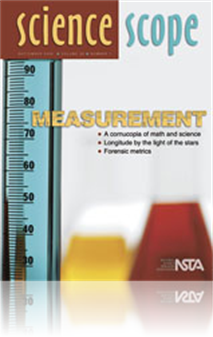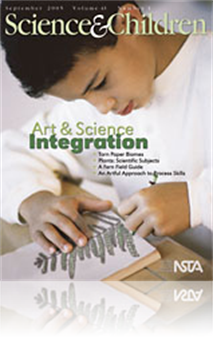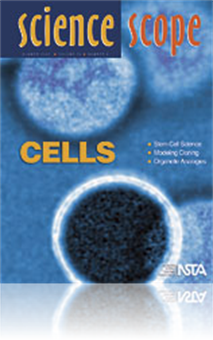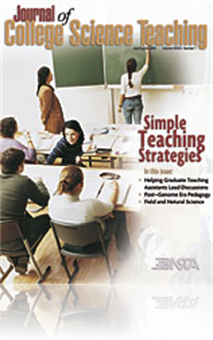All Resources
Journal Article
Science Sampler: Forensic metrics
Students have a blast pretending to be crime scene investigators as they use metric measurement for problem solving and inquiry in this exciting activity. Students use measuring equipment, collect data, and make inferences based on the evidence colle...
Journal Article
Science Sampler: Pick-a-number
The Pick-a-number activity, a variation of the game 20 Questions, provides a way to address challenges at the beginning of the school year, in a standards-based way. It also helps students develop the essential skill of asking questions as part of th...
Journal Article
The design of a classroom and how space is used can affect student achievement, classroom safety, and teacher liability. When science teachers and administrators plan and design classroom environments, they should consider four factors that play a ma...
Journal Article
This article focuses on the use of artwork to investigate science-process skills in an interesting and unusual way. Preservice teachers examine a painting and share descriptions of the painting (observations), what they thought might be going on (inf...
Journal Article
Science 101: Where does amber come from?
What aromatic, soft, sticky resin found in trees protects plants by sealing cuts and excluding bacteria, fungi, and insects? You guessed it, amber! This article examines the origins and usage of amber from ancient times to the present....
Journal Article
After the bell - Algebraic Thinking Part II: The Use of Functions in Scientific Inquiry
Functions are not only a necessary mathematical tool for scientific inquiry--the use of functions on standardized tests is increasing to the point where students must be proficient in the subject. This activity, the identification of the outside te...
Journal Article
Science and art blend when students identify the ferns growing on their school grounds. Second- and third-grade students worked together to discover plants on the school grounds. This project culminated in the creation of a “Guide to the Common Fer...
Journal Article
Teaching Through Trade Books: What's Up with Sinking?
Two trade books invite students to explore the question: To sink or not to sink? That is the experiment. Though both books are targeted for younger children, teachers can use these books with elementary students of any age to spark interest in sci...
Journal Article
Science Sampler: Inquiry into measuring
It is important for students to understand that numbers in science often involve measurements and that measurements have limited precision. The following two activities demonstrate the limitations of measurement tools and explore the varying degree o...
Journal Article
Colors can open the door to an invisible world of electromagnetism, even when children can barely imagine things they cannot see. This article looks at color as a powerful tool for engaging children of all ages. A corresponding activity is included....
Journal Article
Habits of Mind for the Science Laboratory
Laboratory experience should be an integral part of any high school science program, especially laboratory activities designed so that students gather data, explore concepts, and answer questions through inquiry. So, how can science teachers avoid ne...
Journal Article
Methods and Strategies: Why Demonstrations Matter
As a teacher, it is important to build lessons around concepts and utilize demonstrations as an integral part of concept development in science. Demonstrations are easy to do and offer many benefits and unique opportunities in the constructivist clas...
Journal Article
Scope on the Skies: Planets in motion
September is a great month to watch Venus, Jupiter, and Mars in action. These planets will be visible as they move across the sky, and can be viewed with the naked eye. Take this opportunity to plot planetary motion using the internet resources cont...
Journal Article
Johnny Appleseed Comes to Class
Elementary life science methods professors found that their students often misunderstood the connection between flowers and fruits. Johnny Appleseed helped to solve this quandry by making a visit to provide an engaging atmosphere for elementary stud...
Journal Article
Promoting problem-solving skills is a challenge faced by all science instructors. Teaching students to integrate information without sacrificing content is critical. When taught with an active problem-centered teaching model, students’ mean scores ...
Journal Article
Twentieth-century novelist and physicist C.P. Snow famously stated that solving the world’s complex problems requires collaboration between humanists and scientists. We agree with Snow and illustrate one integrated educational approach that bridges...
Journal Article
The Early Years: What Can Young Children Do as Scientists?
Children come to our classrooms with varying amounts of experience in exploring the natural world and participating in scientific inquiry. The school year's first meeting for science instruction can be a time to take stock of the breadth and depth o...
Journal Article
Creating Case Study Presentations: A Survey of Senior Seminar Students
Senior seminar students were surveyed on their opinions of a course that required them to create and present original formal case studies; this resulted in an accumulation of quantitative and qualitative data that were supportive of the case study me...
Journal Article
Scope on Safety: Plant the seeds of knowledge
Why use plants in your science laboratory? First of all, they are an excellent way to implement hands-on, inquiry-based science at the middle school level. Second, plants help students better understand the role of plants in the ecosystem and general...
Journal Article
Science Sampler: The clone factory
Have humans been cloned? Is it possible? Immediate interest is sparked when students are asked these questions. In this activity, students reenact the cloning process, in a very simplified simulation. After completing the process, students discover w...
Journal Article
This article offers an opportunity to nurture the lifelong learner deep inside with a summer reading list that will allow you to renew, reflect, and refresh. NSTA Recommends reviewers share what they're reading this summer....
Journal Article
Who would have thought that a primary level science camp would spark exciting science programs for the more than 1,000 elementary students in one school district in Stephenville, Texas? This article details the development of a science camp for kinde...
Journal Article
Tech Trek: Testing the pH of soft drinks
Students will ooze with enthusiam as they explore acids and bases in soft drinks. To obtain a numerical value for pH, students can use a probe connected to a graphing calculator or computer as part of a hands-on investigation that they can identify w...
Journal Article
This article offers instructions on developing a board game centered on environmental stewardship and its science-technology-society implications. The board game, in which students in grades three through five work in cooperative teams to “save the...
Journal Article
Research and Teaching: Who Does Extra-Credit Work in Introductory Science Courses?
On the first day of classes, 81% of students in an introductory biology course claimed that they would submit extra-credit work if given the opportunity. When given two chances for extra-credit work, fewer than one-fourth of students submitted one or...









